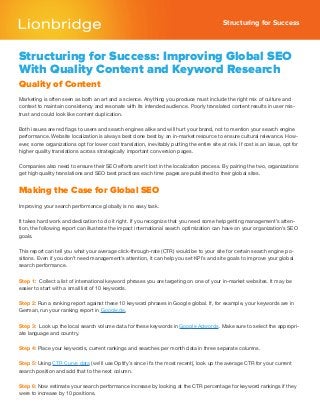
Structuring for Success: Improving Global SEO With Quality Content and Keyword Research
- 1. Structuring for Success Structuring for Success: Improving Global SEO With Quality Content and Keyword Research Quality of Content Marketing is often seen as both an art and a science. Anything you produce must include the right mix of culture and context to maintain consistency and resonate with its intended audience. Poorly translated content results in user mis- trust and could look like content duplication. Both issues are red flags to users and search engines alike and will hurt your brand, not to mention your search engine performance. Website localization is always best done best by an in-market resource to ensure cultural relevance. How- ever, some organizations opt for lower cost translation, inevitably putting the entire site at risk. If cost is an issue, opt for higher quality translations across strategically important conversion pages. Companies also need to ensure their SEO efforts aren’t lost in the localization process. By pairing the two, organizations get high quality translations and SEO best practices each time pages are published to their global sites. Making the Case for Global SEO Improving your search performance globally is no easy task. It takes hard work and dedication to do it right. If you recognize that you need some help getting management’s atten- tion, the following report can illustrate the impact international search optimization can have on your organization’s SEO goals. This report can tell you what your average click-through-rate (CTR) would be to your site for certain search engine po- sitions. Even if you don’t need management’s attention, it can help you set KPI’s and site goals to improve your global search performance. Step 1: Collect a list of international keyword phrases you are targeting on one of your in-market websites. It may be easier to start with a small list of 10 keywords. Step 2: Run a ranking report against these 10 keyword phrases in Google global. If, for example, your keywords are in German, run your ranking report in Google.de. Step 3: Look up the local search volume data for these keywords in Google Adwords. Make sure to select the appropri- ate language and country. Step 4: Place your keywords, current rankings and searches per month data in three separate columns. Step 5: Using CTR Curve data (we’ll use Optify’s since it’s the most recent), look up the average CTR for your current search position and add that to the next column. Step 6: Now estimate your search performance increase by looking at the CTR percentage for keyword rankings if they were to increase by 10 positions.
- 2. Using the chart below as a reference, one of the keywords below has an average local search volume of 74,000 queries per month and the current position for this keyword is page one, position seven. If this keyword ranking improved from position seven to position one, traffic would increase by 959 percent, given that a position one ranking has an average CTR of 36.4 percent. GET STARTED To learn more about our Web Globalization solutions, please contact us at globalmarketingops.com/get-started Aaron Hakenson Global Marketing Consultant Aaron.Hakenson@lionbridge.com globalmarketingops.com Follow Lionbridge
